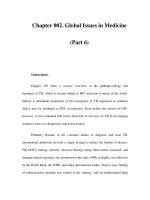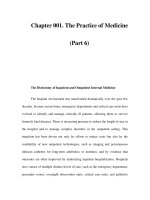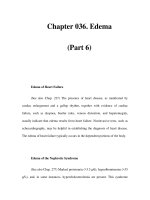ACNE FOR DUMMIES - part 6 ppsx
Bạn đang xem bản rút gọn của tài liệu. Xem và tải ngay bản đầy đủ của tài liệu tại đây (597.29 KB, 34 trang )
Part III: Turning to the Pros to Treat Your Type of Acne
138
However, dark skin does have disadvantages when it comes to
dealing with acne — dark spots and scars are more likely to appear
(more about that later in the chapter).
Our world is host to great variability in skin color among people of
all races. We’re all pretty much the same underneath where it
counts, and making generalizations about acne and race or skin
color is difficult.
But, the following are some of the features that are more likely to
be seen in darker skin types:
ߜ Dark spots are often the number one concern to the person
with acne. Check out the next section that talks about how
they form and what you can do about them.
ߜ Inflammatory (red) acne lesions tend to be less visible.
Lesions appear to be less common in very dark skin because
the red color of inflammation is often well hidden by the sur-
rounding darker skin.
ߜ Sensitive skin known as eczema (atopic dermatitis) is more
common in Asians, African-Americans, and Hispanics.
ߜ Healing acne lesions tend to produce larger scars in Hispanics,
Asians, and particularly African-Americans, as compared to
Caucasians. (I discuss scars in Chapter 16.)
The good news is that people of color are less likely to have
severe nodular acne than are Caucasians.
Figuring Out Those Dark Spots!
People with white skin tend to complain about red marks that
remain red or purplish in color. These spots are called macules in
dermatologese. Like freckles and tattoos, they’re simply color
changes of the skin (you can’t feel macules, and if you close your
eyes, they don’t exist).
In black skin, those same red spots look much darker, even deep
brown or black in color and many shades in between, particularly
after they heal. African-Americans are often more concerned about
these dark acne-related macules than they are about the acne
itself. The dark spots are known as postinflammatory hyperpigmen-
tation or postinflammatory pigmentation — or PIP for short. To see
what PIP looks like, turn to the color section of this book.
18_746983 ch12.qxp 11/29/05 8:47 PM Page 138
Chapter 12: Managing Acne in Dark-Complexioned Skin
139
How dark spots are formed
PIP is limited to the sites of previous inflammation. Think of the
spots as “footprints,” the aftermath or telltale signs that show
where the original injury (inflammatory “battle”) took place. The
original insult (and injury) that caused PIP can be a cut, a burn, a
rash, or the after-effect from a healing acne lesion.
Often these “footprints” disappear over a period of time, but they
always outlast the original inflammatory acne lesions themselves. In
fact, they may take many months or even years to fade completely.
There are actually two types of PIP. Both start off when inflamma-
tion of the skin, such as acne, stimulates the melanocytes in your
epidermis and causes them to step up the manufacturing of
melanin. The production of melanin (melanogenesis) increases in
response to the tanning effect of sun, injuries to the skin such as
burns, cuts, surgeries, as well as the inflammation caused by acne.
The two different types of PIP are
ߜ Epidermal hypermelanosis: The busy melanocytes respond
by handing off their melanin pigment in tiny granules to sur-
rounding keratinocytes, your other epidermal cells. This
increased stimulation and transfer of melanin granules results
in epidermal hypermelanosis. Your skin gets darker, but the
pigment isn’t deep.
The good news is that this type of PIP often responds to topi-
cal bleaching creams, which help to accelerate its disappear-
ance. That’s because the majority of the melanin pigment is in
the epidermis (the top layer of the skin) which allows it to be
treated.
ߜ Dermal melanosis: Dermal melanosis occurs when inflamma-
tion disrupts the basal cell layer, causing melanin pigment to
be released and subsequently “dropped” more deeply into the
dermis where it gets trapped by macrophages (scavenger
white cells). This type of PIP is much harder to treat and may
never fade away completely.
These spots are not scars, and some, if not all, of them will fade in
time, or if necessary, they can be lightened with appropriate treat-
ment (see tips for treating them later in this section). Unless the pig-
ment is very deep, PIP will improve over time. Be an extra patient
patient! The dark spots take the longest to fade. The treatment of
PIP tends to be a difficult and prolonged process that often takes 6
to 12 months to achieve the desired results of depigmentation.
18_746983 ch12.qxp 11/29/05 8:47 PM Page 139
Deterring the dark spots
Because these spots can take so long to disappear, it’s essential to
prevent them from appearing in the first place. Early treatment and
prevention of your acne can help put a stop to them. You should
be aware of those things that put you at greater risk of developing
PIP. For example, you should avoid:
ߜ Squeezing, rubbing, or picking your acne lesions
ߜ Over-the-counter toners, witch hazel, and alcohol products as
well as prescription acne products that may dry and irritate
your skin and lead to PIP
ߜ Harsh soaps and overwashing (for tips on how to properly
wash your face, see Chapter 2)
ߜ Scrubbing with loofahs and buff puffs
ߜ Cosmetics that might aggravate your skin and make your acne
look worse
Part III: Turning to the Pros to Treat Your Type of Acne
140
Preventing PIP
Keisha is a 30-year-old woman who started developing acne in her late 20s. When
I first saw her, the first words out of her mouth were, “What can you do to help get
rid of these scars?” She was referring to dark spots on her cheeks and forehead.
“They won’t go away. I hate them,” she said.
I looked closely at her skin and told her that she didn’t have scars. Those dark spots
were where her acne had healed; the spots were PIP. I examined her more thor-
oughly and noted that she did have active acne lesions on her face in addition to the
“inactive” dark spots.
I explained to her that her “active” acne lesions caused those spots and that our first
priority was to treat and prevent the “hot spots” and let the dark spots take care of
themselves.
We began by treating her acne, and when she returned six weeks later, her acne
was getting under control and the dark spots were beginning to fade. After a total
of three months of treatment, her skin tone was evening out and she was quite
pleased.
I reassured her that if any of the dark spots remained after six to eight months of
the current treatment, I would give her additional medications to apply to try to
bleach them.
18_746983 ch12.qxp 11/29/05 8:47 PM Page 140
I know, it’s tempting to think that squeezing spots will help them
heal more quickly. In fact, squeezing actually makes them worse.
Squeezing a spot carries a risk of scarring because the pus can
burst inward into the skin rather than outward to the surface.
In fact, any situation where the skin can be irritated, be it squeez-
ing blemishes, or plucking hair, can result in dark skin’s tendency
to produce more melanin and create dark spots.
Shaving the beard can also wreak havoc with acne and increase the
possibility to develop PIP. Check out Chapter 19, where I provide
some helpful tips on gentle shaving techniques.
Keeping Acne and Dark Spots
at Bay with OTC Medications
The same medications that are used to treat acne in Caucasian skin
are also used to treat people of color; however, when there is a
potential to develop PIP, you sometimes need to use the medica-
tions differently.
If after eight weeks of self-treatment, your acne and your dark
spots persist, seek professional help from your healthcare provider
or a dermatologist. In Chapter 8, I tell you how to find the right pro-
fessional to help you treat your acne.
PIP may further darken with sun exposure, so to be truly effective,
any therapy should include applying a sunblock over any acne or
bleaching medications you use. Other measures to limit ultraviolet
exposure (for example wearing hats, protective clothing, and —
the best option — avoiding the sun altogether) should be part of
your routine.
Benzoyl peroxide and salicylic acid
Over-the-counter (or OTC) medications such as benzoyl peroxide
and salicylic acid may be an excellent approach if your acne is mild
and you’re able to tolerate these products, but they can be quite
irritating on some people’s skin. I discuss these products in greater
detail in Chapter 7.
Chapter 12: Managing Acne in Dark-Complexioned Skin
141
18_746983 ch12.qxp 11/29/05 8:47 PM Page 141
Begin with a benzoyl peroxide preparation. If your skin is able to
tolerate it and you see improvement of your acne, stick with it. If
you want a further boost to your treatment, try adding an over-the-
counter salicylic acid at another time of day or just apply it over
the benzoyl peroxide.
Apply a sunscreen over any medication(s) you are using.
Benzoyl peroxide and salicylic acid can be irritating and drying
and produce whitish scales on dark skin. These scales are often
referred to as looking “ashy.” The appearance of the scales is diffi-
cult for some people to tolerate. (Light skin or white skin gets ashy
too; it’s just that you don’t see the contrast as well.)
If benzoyl peroxide or salicylic acid is producing ashiness and
scales, apply a light non-oily moisturizer like Cetaphil Moisturizing
Cream or Olay Active Hydrating Beauty Fluid. If you have dark
spots, use a moisturizer that contains a sunscreen such as Purpose
Moisturizer SPF 15 or Cetaphil Daily Facial Moisturizer SPF 15. If
you prefer, you may use a heavier, greasier moisturizer.
If you have sensitive skin, be sure to use the lower strength (like
2.5 percent benzoyl peroxide water-based) products to start with.
Start treatment every second night, then build up to once or twice
daily, as you’re able to tolerate the product. Similarly, if you get too
ashy or irritated from salicylic acid products that have a mild peel-
ing activity, try using the lower 1 percent concentration or try
applying the medications on an alternate-day basis.
Over-the-counter bleaches
For the PIP spots, look for over-the-counter preparations that con-
tain 1 to 2 percent hydroquinone, a chemical that’s traditionally
been the main treatment for PIP. Companies that make over-the-
counter hydroquinone-containing “fade” creams and gels include
Ambi, Esoterica, Porcelana, and Black Opal. These products are
applied as a thin layer on the affected areas once or twice a day.
You may experience a mild skin irritation or temporary skin dark-
ening. If skin irritation or darkening persists, stop using them and
seek professional help.
If no improvement is seen after three months of treatment, their
application should be discontinued.
Part III: Turning to the Pros to Treat Your Type of Acne
142
18_746983 ch12.qxp 11/29/05 8:47 PM Page 142
Some of these agents contain a built-in sunscreen, however, sun
exposure should be limited further by using an additional sun-
blocking agent or protective headgear to shade treated skin or
lightened skin.
The over-the-counter products may be helpful, but if they aren’t
strong enough, you may require one of the prescription strength
medications that I describe later in this chapter.
There are over-the-counter products containing 10 percent hydro-
quinone or higher that are available in many other countries, par-
ticularly within Africa and Asia, and some of them have found their
way (illegally) into “health” stores in the United States — mostly in
ethnic neighborhoods within big cities. These high concentrations
actually bring the risk of a darkening reaction known as ochronosis.
Getting Professional Help
Acne treatments are generally as safe and effective on dark skin as
they are on light skin. And in most cases, the treatments are the
same. In Chapters 8 through 11, I outline the topical and oral
approaches that dermatologists commonly suggest and that are
also appropriate for people with darker skin. The main difference
in the professional treatment of darker skin is a deeper concern for
skin discoloration or scars from acne.
In this section, I fill you in on how treatments differ when used on
darker skin, including aggressive treatments of the acne and the
use of more potent skin lighteners for PIP. When treating dark skin,
a combination of topical creams and gels, chemical peels (see the
“Treating your acne and PIP with topical drugs” section, later in
the chapter), and sunscreens may be necessary for significant
improvement. This combination of various topical therapeutic
agents has been shown to be beneficial, especially on the face.
Daily use of a broad-spectrum sunscreen (SPF 15 or greater) is an
essential part of any therapeutic regimen. This step is very impor-
tant to prevent the pigmentation from becoming darker or allowing
the already lightened skin to repigment.
The treatment of PIP tends to be a difficult and prolonged process
and may not work at all. When it does work, it often takes 6 to 12
months to achieve cosmetically acceptable depigmentation.
Chapter 12: Managing Acne in Dark-Complexioned Skin
143
18_746983 ch12.qxp 11/29/05 8:47 PM Page 143
Treating your acne and
PIP with topical drugs
A variety of topical treatments have been used to treat epidermal
PIP, with varying degrees of success. These agents include chemi-
cal peels, retinoids, azelaic acid, and hydroquinone. Lightening of
dark areas may be achieved with one of these topical measures.
Each of these treatment options potentially improves epider-
mal hypermelanosis, but none are proven effective with dermal
hypermelanosis.
Bleaching with prescription-strength hydroquinone
Hydroquinone is the cornerstone agent in the treatment of PIP. It’s a
topical bleaching agent that suppresses the melanocytes from pro-
ducing melanin. Hydroquinone-containing combination products
such as EpiQuin Micro, Glyquin XM, Lustra-AF, and Triluma are
available by prescription only. Some of these agents contain their
own sunscreens. In addition, some contain vitamin E, vitamin C,
retinol, or glycolic acid.
There are unsubstantiated claims that some of these chemicals
have “age-defying,” sun-blocking, wrinkle-preventing properties
when mixed with the hydroquinone. I really can’t give you any
opinion on those claims because with such a mixture of ingredi-
ents, it’s hard to tell what each one does.
Hydroquinone may be prescribed along with azelaic acid (described
later in the next section) to lighten the dark areas more quickly.
Preparations that contain hydroquinone are applied twice a day to
the dark spots. Allergic reactions to them are rare.
Hydroquinone combination products are very expensive and are
almost never covered by prescription plans because hyperpigmen-
tation is considered a “cosmetic problem” for which treatment is
“not medically necessary.” I tell you this so you don’t suffer “sticker
shock” when you go to the pharmacy.
Some dermatologists will ask that a more concentrated prescrip-
tion (up to 8 percent hydroquinone, instead of the usual 3 to 4 per-
cent) be mixed (compounded) for you if you don’t respond to the
lower strength treatments.
Applying azelaic acid
Some products actually treat acne and bleach PIP, saving you
money and valuable application time. Azelaic acid, a prescription
Part III: Turning to the Pros to Treat Your Type of Acne
144
18_746983 ch12.qxp 11/29/05 8:47 PM Page 144
product known as Azelex or Finerin, is an inhibitor of melanin syn-
thesis. It can treat your acne and lighten the dark spots at the
same time. Apply a small amount once or twice a day to all acne-
prone areas including the dark spots. For more information on aze-
laic acid, see Chapter 9. Acne tends to respond to azelaic acid in
six to eight weeks; however, the PIP spots may take many months
to lighten.
Because azelaic acid decreases pigmentation, it can temporarily
lighten areas that aren’t targets of your treatment. It can also be
irritating.
Relying on retinoids
Topical retinoids can also perform a double duty. In addition to the
beneficial actions of the retinoids in treating and preventing both
comedonal and inflammatory acne, they also may have a lightening
effect on PIP. Adaplene (Differin), tazarotene (Tazorac), Avita, and
tretinoin (Retin-A) are all prescription retinoids. See Chapter 9 for
a complete discussion of these medications.
Retinoids are known to hasten the rate of turnover (get rid of dead
cells, in plain English) of epidermal keratinocytes (the majority of
the cells that make up the epidermis) and they also seem to assist
in the normalization of pigmentation as well. Furthermore, by caus-
ing the skin to peel, they enhance the penetration of the other
bleaching medications into the epidermis.
Creams are the least irritating, so you probably should start out
with a cream-based retinoid instead of a gel. If you have oily skin
or have a low risk for irritation, you may be prescribed a gel formu-
lation with a higher concentration of retinoid in it.
Topical retinoids can be effective; however, they can be a “double-
edged sword” if you have very sensitive skin. These products may
result in more irritation that may ultimately cause more PIP.
Peeling the pigment away
It’s possible to actually remove some layers of skin over time to
remove layers of the pigment. The following procedures should be
approached with great caution and performed only by a profes-
sional with a lot of experience in their use (for more details on
these procedures, check out Chapter 14). The risk of worsening
the PIP is always present with all of these procedures.
Chapter 12: Managing Acne in Dark-Complexioned Skin
145
18_746983 ch12.qxp 11/29/05 8:47 PM Page 145
Chemical peels
Glycolic or salicylic acid peels can be effective treatments of PIP in
dark-complexioned individuals. These are superficial peels that
don’t penetrate below the upper layers of skin, and they can some-
times help to even irregular skin tones and lighten PIP. Matching
the strength of a peel to an individual’s skin type and scarring his-
tory is critical to avoiding complications.
Salicylic and glycolic acids may be applied by an experienced der-
matologist or cosmetic surgeon. They may need to perform the
peel multiple times in order to see improvement. Depending on the
strength of the acid peel, you may be asked to discontinue apply-
ing some or all of the topical agents that are described in the previ-
ous sections for a few days before the peel, and resume using them
several weeks after the peel, to maintain the results.
These procedures need to be approached cautiously as the risk of
peel-induced PIP is well known, as well as the risk of hypertrophic
scarring and keloid formation that tends to occur to the more darkly
complexioned individual. In Chapter 16, I tell you more about hyper-
trophic scars and keloids.
Lasers
Certain lasers are now being used to treat PIP, but should only be
used by experienced medical professionals. People with dark skin
have been told in the past that laser treatments aren’t safe for
them. But experts using the lower powered treatments at very spe-
cific wavelengths that are now available can help you avoid com-
plications, such as exacerbating PIP or producing scars.
Microdermabrasion
This procedure is a superficial exfoliation that may not be suitable
for skin of color, but it is sometimes used to treat PIP and smooth
skin texture. It can be effective in reducing superficial hyperpig-
mentation; however, pigmentary streaking and worsening of PIP
may occur in people with dark skin types.
Managing the scars
Acne scars can form after cysts and nodules heal. Even minor out-
breaks of inflammatory acne can result in significant scarring if
you’re predisposed to form larger scars as is the case in many
African-Americans.
Acne scars are difficult to treat, and keloids, large scars that grow
way beyond the bounds of normal scars, are particularly difficult
Part III: Turning to the Pros to Treat Your Type of Acne
146
18_746983 ch12.qxp 11/29/05 8:47 PM Page 146
to deal with. Intralesional cortisone injections, though, are particu-
larly effective for patients of color. As with inflammatory nodules
and cysts, cortisone injections are sometimes injected directly into
the scars to help shrink them. In these instances, higher concentra-
tions than are used to treat active acne lesions are used. Other pro-
cedures, such as soft tissue fillers, scar revision, and laser surgery,
may also be considered (see Chapter 16).
Caution must be used with all of these procedures because of the
risk of creating further scarring and PIP. Therefore, only an expe-
rienced dermatologist or other cosmetic surgeon who is knowl-
edgeable about skin of color should perform these corrective
procedures. The method known as dermabrasion, used to remove
deep scars, can sometimes be too risky to use on people with
dark skin because it has a likelihood that it will make scarring
and PIP worse.
The newest treatment of keloids and hypertrophic scars is to
have them shaved flat or excised (cut out) by a dermatologist or
plastic surgeon. After the procedure is done, the patient applies
topical imiquimod (Aldara) cream for at least 8 weeks. There have
been optimistic reports that there are fewer recurrences with this
method.
Oral acne therapy to prevent
scars and PIP
The use of oral therapy doesn’t differ much according to the rela-
tive lightness or darkness of one’s skin. But sometimes a more
aggressive approach with oral antibiotics such as one of the oral
tetracyclines (see Chapter 10) will get the less visible, “under-the-
skin” papules and nodules under control and prevent the more
obvious postinflammatory hyperpigmentation (PIP) and the more
complicated hypertrophic scars and keloids that can result from
them. Scar treatment is covered in Chapter 16.
Looking at Pomade Acne
African-Americans and other individuals who have tight curly hair
frequently use pomades (oils and greasy ointments) to style or
improve their hair’s manageability. Some people believe that
pomade acne is caused by the pomade’s blockage of pores and that
as a result, many pomade users develop blackheads and white-
heads, with perhaps a few papules and pustules on the forehead
Chapter 12: Managing Acne in Dark-Complexioned Skin
147
18_746983 ch12.qxp 11/29/05 8:47 PM Page 147
and/or temples — places where the pomade comes into contact
with their skin. To see what pomade acne looks like, take a look at
the color section of the book.
Pomades can also contribute to an inflammation or infection of
the scalp, called folliculitis, in which pustules and redness
develop around the hairs. This type of folliculitis can cause hair
loss and scarring of the scalp. I talk about hair follicle problems
in Chapter 19.
My best advice to you is to stop using pomades. If your acne per-
sists after stopping, be sure to see a dermatologist. However, if you
feel your life or hairstyle can’t be complete without pomade, you
still have a couple options to reduce potential problems:
ߜ If you’re using pomade to deal with a dry scalp, try applying
the pomade 1 inch behind your hairline.
ߜ If you’re using it to style or make your hair more manageable,
try applying the pomade to the ends of your hair only, to
avoid contact with your scalp and hairline.
Cosmetics for Women of
Various Ethnic Groups
Dark-complexioned women tend to be more concerned about skin
tone and having a clear, even complexion than they are about wrin-
kles and fine lines.
Until recently, most skin-care companies have neglected African-
Americans and other ethnic consumers. Ethnic cosmetic brands
were available, but their products were far fewer than those in
Caucasian makeup lines.
In the past decade, things have markedly improved and there are
now many companies that offer skin-care products for women of
color. The color spectrum has broadened to include a wider vari-
ety of darker color shades for you to match your skin tones and
conceal your acne while not irritating or worsening it. Products for
Asian women are still few in number; however, Shiseido now offers
a full line of products for the Asian woman. Your dermatologist
may be able to recommend cosmetic measures to make the PIP
spots less apparent until they resolve.
Part III: Turning to the Pros to Treat Your Type of Acne
148
18_746983 ch12.qxp 11/29/05 8:47 PM Page 148
You may have a problem in choosing the right cosmetic if you have
uneven skin tones that represent an uneven distribution of your pig-
mentation, such as appears in PIP. Some areas are darker while some
appear lighter. In such cases, you should match your foundation to
the most predominant color, or find one with a shade in between the
two. Experiment and sample before you buy. Pigmented makeup
creams have also been successfully used to camouflage hyperpig-
mented skin to a shade similar to that of the surrounding unaffected
skin.
Some companies can custom-blend foundation colors, but this may
be very expensive; Dermablend (www.dermablend.com) and
Covermark (www.covermark.com) are two such products.
They’re available in many shades that can be easily blended to
match any skin tone. In fact, they can be used for people of all skin
colors. Besides acne spots, they can be used to conceal skin
imperfections such as birthmarks, burns, and discolorations from
surgery. These products can be found in makeup counters in some
department stores and also can be obtained online.
Of course, PIP occurs just as often in males; however, most males
would not use camouflaging methods as readily as females to try
to hide it.
Chapter 12: Managing Acne in Dark-Complexioned Skin
149
18_746983 ch12.qxp 11/29/05 8:47 PM Page 149
Part III: Turning to the Pros to Treat Your Type of Acne
150
18_746983 ch12.qxp 11/29/05 8:47 PM Page 150
Chapter 13
Attacking Acne with
Accutane and Other
Isotretinoins
In This Chapter
ᮣ Going over the terminology
ᮣ Getting to know isotretinoin
ᮣ Preparing for treatment
ᮣ Taking your medicine
I
f your acne is really severe and hasn’t responded to other types
of therapy, your dermatologist may turn to isotretinoin, com-
monly known by its original brand name, Accutane. Isotretinoin is
a powerful oral medication and, so far, it’s the only treatment that
induces a long-term, drug-free remission of severe acne.
The vast majority of people who have taken isotretinoin bear wit-
ness to the dramatic reduction in acne symptoms and a prolonged
improvement they’ve experienced even after only one course of
15 to 20 weeks of isotretinoin. Okay, then, why don’t I and all the
other dermatologists out there simply install an isotretinoin vend-
ing machine in our waiting room?
There are three main reasons why isotretinoin treatment must be
closely monitored (I thoroughly cover all three in this chapter):
ߜ If taken during pregnancy, isotretinoin is highly likely to cause
severe birth defects.
ߜ There are many other possible side effects that can occur
with isotretinoin use. They range in seriousness from dry lips
to persistent headaches and temporary hearing loss.
19_746983 ch13.qxp 11/29/05 8:45 PM Page 151
ߜ Isotretinoin may be linked to an increased risk of depression
and suicide in people who take it.
Before going any further, I must tell you that most dermatologists
believe that for those who have severe acne, the benefits of
isotretinoin far outweigh the risks if the drug is taken as prescribed
and specific cautions are followed. In this chapter, I explain why
we’re of this opinion and I give you details about the drug and pre-
cautions you can — and must — take, including the new program
established in the United States to regulate access to this drug. But,
as only your doctor can prescribe isotretinoin, he has the definitive
word on all aspects of your treatment, so follow instructions and
ask questions. And for before and after photos of a woman who has
taken isotretinoin, see the color section of this book.
You Say Accutane,
I Say Isotretinoin
Isotretinoin (its chemical name is 13-cis-retinoic acid) is related to
both tretinoin (retinoic acid) and retinol (vitamin A). Isotretinoin is
derived from vitamin A, which makes it a retinoid. (I discuss topical
retinoids that dermatologists prescribe in Chapter 9.) In Canada,
the United Kingdom, Australia, and Europe, isotretinoin is available
as a topical, as well as an oral, preparation to treat acne.
When isotretinoin is taken orally, it’s classified as a teratogen, which
means that it’s a substance that can cause deformities in a fetus.
The original brand names for oral isotretinoin were Accutane in
the United States and Roaccutane in rest of the world. Besides,
Accutane and Roaccutane, it’s now sold under several generic
brand names in the United States, including
ߜ Amnesteem
ߜ Claravis
ߜ Sotret
For our purposes, I simplify matters and simply call it isotretinoin.
(For a complete listing of isotretinoin brand names in your neck of
the woods, check out my guide to acne drugs around the world in
Appendix B.)
Part III: Turning to the Pros to Treat Your Type of Acne
152
19_746983 ch13.qxp 11/29/05 8:45 PM Page 152
Getting to Know the
Drug and Its Uses
Isotretinoin is so effective because it has the ability to hit specific
targets at the root of acne. (In Chapter 3, I go into all of the details
about how acne forms.) Isotretinoin treats acne by:
ߜ Stopping the excess oil production: Isotretinoin dramatically
reduces the size and output of your sebaceous glands. It
limits the amount of sebum and thus cuts off the acne bacte-
ria’s (technically known as P. acnes) food supply. Stemming
the flow of oil explains the many drying side effects that I
describe later in this chapter.
ߜ Stabilizing keratinization: Keratinization is the process
through which keratinocytes (epidermal cells) produce the
protein keratin. When acne occurs, the dead cells that are
located in your hair follicles are shed more frequently and in
an abnormal fashion. Isotretinoin helps you to more normally
shed away dead skin cells, so that they are less likely to clog
your pores. This process prevents comedones (whiteheads
and blackheads) from forming. I explain the formation of
comedones and keratinization in Chapter 3.
Doctors usually prescribe isotretinoin after other acne treatments
have failed to produce satisfactory results. Isotretinoin should never
be the therapy of first choice. It must be demonstrated that you’ve
been unresponsive to other standard therapies — the course of
which usually begins with topicals (see Chapters 7 and 9), and
moves onto oral antibiotics (or a combination of oral antibiotics and
topicals, as I discuss in Chapter 10), or antiandrogens in women (see
Chapter 11), all of which produce far fewer side effects than does
isotretinoin.
Because of its serious side effects (see “Knowing What to Expect
When You Take Isotretinoin” for more information), isotretinoin
should be used only for severe, resistant acne. The drug isn’t for
everyone. However, when any of the following types of acne exist,
isotretinoin may be considered (as the final therapeutic option):
ߜ Severe nodular acne that can’t be cleared up by any other
acne treatments including oral antibiotics
ߜ Inflammatory acne with scarring that has failed conventional
treatment
ߜ Moderate-to-severe acne with frequent relapsing
ߜ Acne with severe psychological distress
Chapter 13: Attacking Acne with Accutane and Other Isotretinoins
153
19_746983 ch13.qxp 11/29/05 8:45 PM Page 153
I need to emphasize that those last three reasons to use isotretinoin
are considered to be “off-label,” meaning that the U.S. Food and
Drug Administration (FDA) hasn’t approved isotretinoin for these
conditions. Off-label use doesn’t imply that the drug is being used
improperly or illegally. The decision to prescribe isotretinoin for
the final three reasons has been based on many years of clinical
experience and a careful consideration of the potential risks and
benefits in the use of the drug.
Isotretinoin can cause severe birth defects if taken by a pregnant
female or a woman who becomes pregnant while taking the drug —
even for a short time. Because the drug stays in the body’s system
for a long time, it can cause birth defects for one month after a
woman has stopped taking it. Isotretinoin also carries an increased
risk of miscarriage when used during pregnancy or up to one month
prior to pregnancy. Studies done in males taking isotretinoin showed
no significant effects on their sperm and no long-term damage to a
male’s ability to have healthy children.
Some of the birth defects include:
ߜ Skull abnormalities
ߜ Heart defects
ߜ Deafness
ߜ Cleft palate
ߜ Central nervous system defects
In the treatment of females of childbearing potential, isotretinoin
should be used only for patients with severe, disfiguring, cystic
acne.
If you have unprotected sex without birth control, miss your
period, or become pregnant while you’re taking isotretinoin, call
your dermatologist immediately!
Preparing for Treatment
Isotretinoin’s toxicity during pregnancy has long been known, but
past efforts to reduce birth defects, including stricter product label-
ing and a limited pregnancy testing system, failed to resolve the
problem. Therefore, in 2005, the FDA established an isotretinoin
federal registry program called iPLEDGE. The program is geared
toward reducing the number of birth defects, miscarriages, and
abortions associated with the drug. The iPLEDGE program only
applies to prescriptions for isotretinoin that are written in the
Part III: Turning to the Pros to Treat Your Type of Acne
154
19_746983 ch13.qxp 11/29/05 8:45 PM Page 154
United States. But the precautionary information is valid no matter
where you live, and many of the same procedures are followed
throughout the world.
The registry keeps tabs on all isotretinoin prescriptions in the
United States. Manufacturers, wholesalers, pharmacists, pre-
scribers, and patients are linked through a centralized computer
registry. The registry also connects to the laboratories that perform
the required pregnancy testing in this system (see the next section,
“Procedures all patients must follow,” for details). Physician and
patient identification codes are intended to protect the privacy of
patients.
Unfortunately, some dermatologists and other healthcare providers,
maybe yours, will stop prescribing isotretinoin rather than take on
the time-consuming workload inherent in the iPLEDGE registry.
Note: In this section, I use the term prescriber to refer to the person
who writes the isotretinoin prescription, whether it’s your derma-
tologist or primary care provider.
Procedures all patients must follow
Everybody in the United States who is prescribed the drug, includ-
ing females who can’t get pregnant and males, must register with
iPLEDGE.
The registration procedure requires your prescriber — or a desig-
nated person in your prescriber’s office — to connect with the
iPLEDGE Web site or phone system to enroll you into the system
before being permitted to prescribe isotretinoin. Reactivation must
be done on an annual basis. After you’re registered and been pre-
scribed isotretinoin, your prescriber must confirm to the registry
that you are receiving ongoing counseling each month while taking
the drug. A monthly review about birth-control requirements is
especially crucial for female patients of childbearing potential (see
the following section).
In addition to keeping tabs on all the prescriptions, registering
everyone is meant to discourage men from sharing their isotretinoin
with a girlfriend, sister, wife, and so on and to discourage women
from asking men they know to get isotretinoin for them.
Before starting treatment, your isotretinoin prescriber will order a
lot of blood tests. A complete blood count, liver function studies,
and triglyceride and cholesterol levels should be determined
before treatment begins. That’s because isotretinoin can cause
Chapter 13: Attacking Acne with Accutane and Other Isotretinoins
155
19_746983 ch13.qxp 11/29/05 8:45 PM Page 155
changes in the blood and the liver. Your prescriber will likely con-
tinue to order more tests as treatment continues.
Your prescriber will also explain the risks and requirements for
safely using the drug, and have you or your parent or guardian sign
a consent form that says you understand the risks associated with
isotretinoin, including possible birth defects as well as the possi-
bility of depression and suicide. (Pharmacists must also hand out a
detailed warning brochure.)
All patients, male or female, are only allowed a 30-day supply of
isotretinoin at each office visit. These prescriptions are only valid
for seven days after they’re prescribed.
You must be reliable and capable of understanding the prescriber’s
instructions on the use of isotretinoin and the risks involved, and
be willing to comply with these instructions.
Be sure to talk to your doctor about any of the following conditions
that you or a family member may have:
ߜ Allergies to foods or medicines
ߜ Anorexia nervosa
ߜ Asthma
ߜ Diabetes
ߜ Heart disease
ߜ Liver disease
ߜ Mental problems
ߜ Osteoporosis
Additionally, tell your doctor if you’re taking phenytoin (Dilantin),
because using it in combination with isotretinoin may weaken your
bones.
Additional steps females must take
Because isotretinoin is harmful to the fetus and therefore shouldn’t
be used during pregnancy, women of childbearing age must
commit to additional testing and compliance in order to receive
isotretinoin.
Table 13-1 contains a breakdown of the monthly responsibilities
that you, your prescriber, and your pharmacist share within the
iPLEDGE program if you’re a woman capable of having children.
Part III: Turning to the Pros to Treat Your Type of Acne
156
19_746983 ch13.qxp 11/29/05 8:45 PM Page 156
The discuss these requirements in the following sections (for more
information you can check out www.ipledgeprogram.com and
talk to your prescriber).
Table 13-1 Monthly iPLEDGE Requirements for
Females Capable of Having Children
Individual Interaction
Your doctor Confirms that you’ve received contraceptive counseling
Enters the two types of contraceptives that you’ve chosen
to use
Enters your pregnancy test results
You Answer educational questions before each prescription
Enter the two types of contraceptives that you’ve chosen
to use
Your pharmacist Checks with iPLEDGE to get authorization to fill the
prescription.
In addition to these steps, you also need to avoid becoming preg-
nant for at least one month after stopping isotretinoin treatment.
And because of isotretinoin’s potentially serious side effects, nurs-
ing mothers should unquestionably not use it.
Male patients who are taking isotretinoin should be informed
about the risk associated with use during pregnancy, emphasizing
that they shouldn’t share the drug with females.
Birth control discussion
You must discuss birth control methods with your prescriber or a
healthcare professional with expertise in contraception, such as a
gynecologist. Such counseling and patient education are prerequi-
sites to obtaining isotretinoin prescriptions.
Two negative pregnancy tests
Two negative pregnancy tests before you start isotretinoin are nec-
essary. The first test (a screening test) is done when the decision is
made to start isotretinoin. The second test (a confirmation test)
must be done during the first five days of your menstrual period
right before starting isotretinoin. You won’t get your first prescrip-
tion for isotretinoin until there is proof that you have had two neg-
ative pregnancy tests.
Chapter 13: Attacking Acne with Accutane and Other Isotretinoins
157
19_746983 ch13.qxp 11/29/05 8:45 PM Page 157
The pregnancy tests are performed only at certified laboratories
that are CLIA approved. CLIA stands for Clinical Laboratory
Improvement Amendments and was enacted by the United States
Congress to ensure the accuracy, reliability, and timeliness of
patient test results regardless of where the test was performed.
Ongoing pregnancy tests during treatment
You continue to have a pregnancy test every month during
isotretinoin therapy. Along with confirming that appropriately timed
initial pregnancy tests performed at a CLIA-approved laboratory are
negative prior to authorizing the dispensing of an isotretinoin pre-
scription for a female patient who is capable of becoming pregnant,
the iPLEDGE registry requires a new pregnancy test before each
refill is authorized.
Use of two separate forms of effective
birth control at the same time
You must be using two of these birth controls at least one month
before beginning therapy, during therapy, and for one month after
isotretinoin treatment has stopped. Effective forms of birth control
include:
ߜ Hormonal birth control — including birth control pills,
patches, long-term injections (like Depo-Provera), and
implants (like Norplant)
ߜ Condoms
ߜ IUDs (or Intra Uterine Devices)
ߜ Diaphragms
ߜ Tubal ligation (having your tubes tied)
ߜ A partner who’s had a vasectomy
The following are unacceptable forms of contraception:
ߜ Progesterone-only minipills that don’t contain estrogen (In
fact, if you’re taking this form of birth control, talk to your
doctor, as it may not work while you’re taking isotretinoin.)
ߜ IUD Progesterone T
ߜ Female condoms
ߜ Natural family planning (rhythm method) or breastfeeding
ߜ Fertility awareness
ߜ Withdrawal
ߜ Cervical shield
Part III: Turning to the Pros to Treat Your Type of Acne
158
19_746983 ch13.qxp 11/29/05 8:45 PM Page 158
All birth control methods (besides total abstinence) can fail.
Discuss the various options with your prescriber or your contra-
ception advisor.
In two specific situations, you don’t need to use these birth control
methods:
ߜ You commit to being absolutely and consistently abstinent (no
sexual intercourse) during and for one month before and one
month after your isotretinoin treatment.
ߜ You have had a hysterectomy (your uterus was surgically
removed).
If you are capable of becoming pregnant — even if you commit to
abstinence — your prescriber may insist that oral contraceptives
are one of the two methods used before starting, during, and for
one month after isotretinoin treatment is completed.
Chapter 13: Attacking Acne with Accutane and Other Isotretinoins
159
Overcoming embarrassment
When she was a 17-year-old girl, Liza was prescribed isotretinoin, which she took for
five months. Before starting the isotretinoin, she was asked by her dermatologist if
she was sexually active or if there was any chance that she might be pregnant. She
was also questioned about her knowledge about birth control methods. She was mor-
tified because she was asked these questions right in front of her father!
After she began taking isotretinoin, she was embarrassed about having to go for
the pregnancy test every month. I explained to her that it would have been irre-
sponsible had the doctor not brought up the issue of pregnancy or if the doctor did
not discuss birth control methods as well. Regrettably, these are embarrassing, but
very necessary topics we must discuss because of the potential serious conse-
quences that can occur if these issues aren’t addressed and understood completely.
Maybe her dermatologist could have been more tactful and spoke to her privately
or asked her to bring her mother on follow-up visits.
As things turned out, Liza was very happy with the results of treatment and her worst
side effect was really, really dry lips. “I went through four or five tubes of Chapstick,”
she said.
19_746983 ch13.qxp 11/29/05 8:45 PM Page 159
Knowing What to Expect when
You Take Isotretinoin
If I haven’t scared you off yet with all the warnings earlier in this
chapter, here’s the section that tells you how to take isotretinoin,
what to look out for, and how to deal with some of its inevitable
side effects.
Taking your pills and
observing results
Isotretinoin is available as capsules in the following strengths: 10,
20, 30, and 40 milligrams. The recommended dose depends on
your body weight. Usually you take a pill with food twice a day for
a total of 15 to 20 weeks. (In Europe, patients are often given lower
dosages for longer periods of time.) Initially, your doctor may
decide to start you off on a low dose so that you can get used to
any side effects and then the dosage can be increased.
Often there is an observable improvement over the first month
that continues over the course of treatment. In the vast majority
of isotretinoin users, complexions smooth out, marks fade, and
acne improves dramatically. Some lesions may still remain after
you have stopped treatment, but many individuals notice that
their acne continues to improve even in the weeks after treatment
has stopped.
Shortly after starting isotretinoin therapy, some people may ini-
tially get worse before they get better. Often that’s because they
stopped all of the other acne medications that they were using up
until then. A minority of isotretinoin users have a more serious
flare at the beginning of treatment. Your dermatologist can manage
this by adjusting the dosage or by adding other medications to
calm things down.
Most people don’t require a second course of treatment; when
needed, it should be resumed only after the drug has been stopped
for four months.
Part III: Turning to the Pros to Treat Your Type of Acne
160
19_746983 ch13.qxp 11/29/05 8:45 PM Page 160
What not to do when you’re
taking isotretinoin
You must avoid certain things while taking isotretinoin, including
the following:
ߜ If you’re a woman, don’t even consider having unprotected
sex while you’re taking isotretinoin.
ߜ Don’t breastfeed while taking isotretinoin and for one month
after stopping.
ߜ Don’t donate blood during treatment or for one month after
stopping treatment. If someone who is pregnant gets your
donated blood, her baby may develop severe birth defects.
ߜ Treatment with tetracycline and isotretinoin shouldn’t be
given at the same time because the combination has been
associated with brain swelling (pseudotumor cerebri).
ߜ Vitamin A should be strictly avoided while undertaking ther-
apy with isotretinoin because they’re closely related to one
another. The use of both vitamin A and isotretinoin at the
same time may lead to added side effects.
ߜ If you’re taking birth control pills, the herbal supplement
St. John’s Wort may make the birth control pills work less
effectively.
Sizing up side effects
Although they’re common, side effects with isotretinoin are usually
tolerable. In general, most folks work through many of the reactions
because the drug is so effective that people with severe acne want
to continue taking it despite some of the bothersome side effects.
Side effects of isotretinoin are dose-related. That means that the
higher the dosage, the greater chance of having side effects. One
way around this problem is for your dermatologist to put you on a
low dosage for a longer period of time. However, females will then
have to continue monitoring pregnancy tests and continue birth
control for a longer period of time.
Mild side effects
Isotretinoin is effective, in part, because it can shut down the oil
production in the body, but this action accounts for some of its
side effects. Because of the great decrease in oil production, even
Chapter 13: Attacking Acne with Accutane and Other Isotretinoins
161
19_746983 ch13.qxp 11/29/05 8:45 PM Page 161
your mucous membranes, such as the inside of your nose, eyelids,
and mouth, lose oil and become very dry. In fact, dryness is the
most common side effect of isotretinoin. This reduction of oil can
result in some of the less serious side effects, such as:
ߜ Dry lips: Dry, chapped, and sometimes cracked lips are the
most common and persistent annoyances from isotretinoin.
These irritating problems occur in just about everybody who
takes the drug. You can deal with them by gobbing on lip
balm. I recommend Vaseline Petroleum Jelly, Chapstick, or
Bag Balm.
ߜ Dry eyes: You may find dry eyes to be a problem, particularly
if you wear contact lenses. You may need to stop wearing
them temporarily, but the frequent use of artificial tears such
as Tears Naturale or Visine True Tears may allow you to con-
tinue using contacts. Artificial tears are used as one or two
drops placed in the affected eye(s), as needed.
ߜ Mild nosebleeds: Nosebleeds occur when the nasal lining
dries out. They’re usually short-lived and can be stopped with
direct pressure. Nosebleeds can be prevented by coating
nasal surfaces with lubricants, such as Vaseline Petroleum
Jelly or Aquaphor ointment.
ߜ Dry skin: You may notice peeling of your palms and soles, or
scaly skin on the backs of your hands and forearms. Helpful
moisturizers such as Eucerin cream, Moisturel, Cutemol, and
Am-Lactin, are all available over the counter.
However, reduction in oil isn’t the only annoying problem you face.
You may also experience:
ߜ Aches and pains: Musculoskeletal symptoms such as pain or
stiffness of large joints or of the lower back occur and are usu-
ally very mild and disappear after a month or so. Try Tylenol
(acetaminophen) if you experience ongoing pain.
ߜ Increased sensitivity to the sun: I know you’re all wearing
sunscreen daily anyway (hint, hint), so apply it more often
and use a higher SPF than you might normally.
ߜ Thinning hair: Less common, but still annoying; some people
have reported thinning hair during treatment. Rarely has this
been a persistent or a permanent problem — the hair gener-
ally grows back when the treatment regimen is over.
Part III: Turning to the Pros to Treat Your Type of Acne
162
19_746983 ch13.qxp 11/29/05 8:45 PM Page 162









